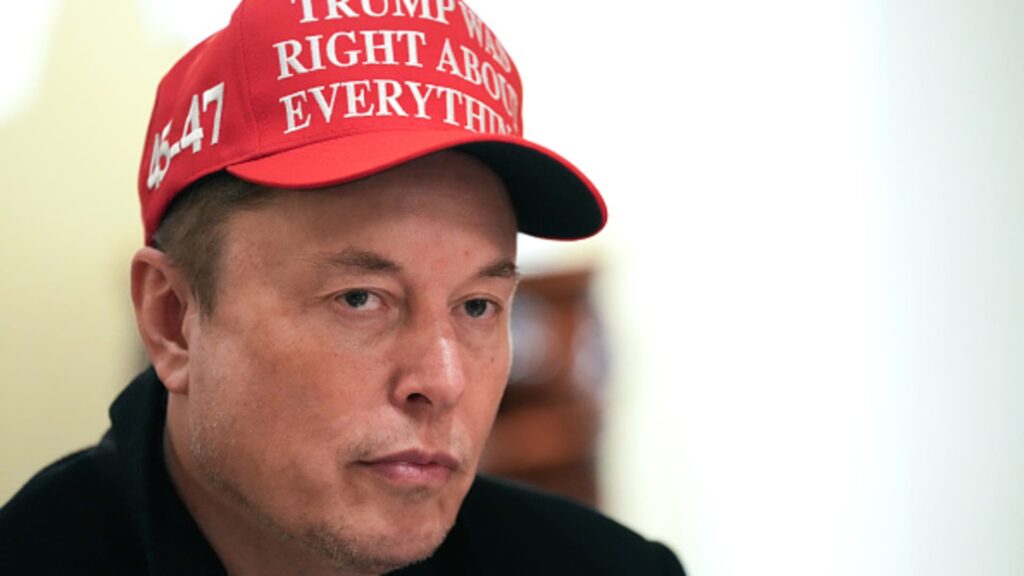White House Senior Advisor, Tesla and SpaceX CEO Elon Musk attends a cabinet meeting held by U.S. President Donald Trump at the White House on March 24, 2025 in Washington, DC.
Win McNamee | Getty Images
Tesla’s stock just wrapped up its worst quarter since 2022 and suffered its third-steepest drop in the company’s 15 years on the public market.
Shares of the electric vehicle maker plunged 36% in the first three months of the year.
The last time Tesla had a worse stretch was at the end of 2022, when the stock cratered 54%. That quarter included CEO Elon Musk’s sale of more than $22 billion worth of Tesla shares to finance his $44 billion acquisition of Twitter, later renamed X. On Friday, Musk said his artificial intelligence startup xAI has acquired X in a deal valuing the social media company at $33 billion.
Tesla’s first-quarter drop wiped out over $460 billion in market cap. The majority of the quarter overlaps with Musk’s time in the second Trump administration, leading an effort to slash government spending and regulations, and terminating tens of thousands of federal employees.
Musk is leading what’s known as the Department of Government Efficiency, or DOGE. As of Monday, the DOGE website claimed that, through March 24, the program had notched $140 billion in federal spending reductions, a number equal to less than one-third of Tesla’s valuation loss in the first quarter.
“My Tesla stock and the stock of everyone who holds Tesla has gone, went roughly in half,” Musk said on Sunday night at a rally he held in Green Bay, Wisconsin, to promote the right-wing judge he’s backing for Tuesday’s state supreme court election. “This is a very expensive job is what I’m saying.”
DOGE’s website contained numerous errors previously, causing the group to revise its own claims about its savings. And many of Musk’s allegations about waste, fraud and abuse in the federal budget have also been shown to be misleading or false.
Musk recently said on a Fox News interview with Bret Baier, that he and DOGE plan to slash $1 trillion from total federal spending levels by May.
Musk’s role in the White House is one factor weighing on Tesla’s stock, as it’s contributing to waves of protests, boycotts and violent attacks on Tesla stores and vehicles around the world. President Trump’s automotive tariffs are also a concern as they involve Tesla’s key suppliers, notably Mexico and China. Tariff fears sparked a broader selloff in tech stocks, with the Nasdaq closing the quarter down 10%, its biggest drop since 2022.
Tesla faces other headwinds, such as a steep decline in new vehicle sales, and pressure to deliver on Musk’s promises for robotaxis while rivals extend their lead in the market.
Musk has said Tesla will launch a driverless ride-hailing business in Austin, Texas in June, but some analysts are voicing skepticism about the company’s ability to meet that deadline.
For about a decade, Musk has promised that existing Tesla cars can be turned into robotaxi-ready vehicles with one more software upgrade. On the company’s fourth-quarter earnings call, Musk said that a forthcoming version of Tesla’s Full Self-Driving software will require a hardware upgrade as well.
While the first-quarter stock drop has been painful for shareholders, they’ve experienced similar volatility in the recent past. In the first quarter of 2024, the shares plunged 29% due to declining auto sales and increased competition. But the stock rallied the rest of the year to finish up 63%.
“Long term, I think Tesla stock is going to do fine,” Musk said at the Green Bay rally. “So, you know, maybe it’s a buying opportunity.”
WATCH: How cutting federal workers impacts government bloat



